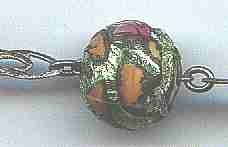Your path =Home> Center for Bead Research > ID Certificates > Example
Bead Identification Certificate 98-2
21 November 1998
Re: Identification of Beads Submitted
|
Tests:
The only physical test performed was to put the beads under an ultraviolet lamp. The white base fluoresced a bright white under the short-wave UV light, indicating the use of tin as colorant and opacifier.
Description:
The beads are lamp-wound oblates, between 13.50 and 14.05 in diameter. Over the white base is a thin yellow-brown coat. On top of this was placed a metal (probably silver) foil, most likely covering nearly all the bead. On this foil was trailed a light translucent green glass in a random pattern over the surface. The silver foil beneath it thus produces a pattern of metallic green, perhaps originally covering half a bead's surface. At intervals, dots of glass were placed, sometimes on the green and sometimes not. These dots were made from canes of pink, white and clear glass and applied with a slight twist so that they resemble rosettes.
Comparisons:
No beads of this sort are listed in any of our reference books. Nor have any been recorded from any collections of Venetian, Czech, other European, Indian or Chinese bead sources.
The only beads similar to these in our collection are those gathered from two different dealers, who could vouch for their Japanese origin because the beads in these group were so labeled. The closest parallel is a smaller milky-white oblate with a brown or perhaps goldstone trailing and smaller "rosettes." Similar beads without the rosettes are found with different colored trails. They are what are commonly called "vintage" Japanese beads. The problem is dating them more precisely.
The only other source of similar beads that I know is the house of Park Che Chun of Seoul, Korea, ca. 1984. Park, like all the founding Korean beadmakers, was taught the craft in Japan during the occupation between 1927 and 1934.
Two other things point to Japan (or conceivably Korea) as the source of these beads. Tin is still commonly used on Japanese beads, as on sample cards in our collection of Daigo Boeki Co., Inc. of Osaka. Daigo Boeki was/is an exporter, not a beadmaker and had/has beads from many sources for sale. Two with white glass beads (one dated to 1976) also contain tin. Venetian beads don't.
Thirdly, the barrel clasp often points to Japanese jewelry.
Date of the Beads:
This is the most difficult aspect of this identification. The beads are not in reference works, including those specifically on Japanese glass or glass beads. The Japanese apparently no longer make lamp-beads for export or general sale (I have not verified this personally). Such beads do not show up on any of the several dozen Japanese sample cards of glass beads in the Center's collection, mostly dating from the 1970s. Thus, they do not represent Edo Period beads (ended 1868), are not the sorts of beads made by Sakubei Oi, who began the modern beadmaking in 1870 (Blair 1973:293), nor are found among 1970s products.
As a guess, I would narrow them down to maybe around 1900 to 1960 and perhaps most likely the period between the two World Wars.
Respectively Submitted,
(signed) Peter Francis, Jr.
Director, Center for Bead Research
Reference:
Blair, Dorothy 1973 A History of Glass in Japan. Tokyo/Corning: Kondasha/Corning.
__________________________________________________
Small Bead Businesses| Beading & Beadwork | Ancient Beads | Trade Beads
Beadmaking & Materials | Bead Uses | Researching Beads | Beads and People
Center for Bead Research | Book Store | Free Store | Bead Bazaar
Shopping Mall | The Bead Auction | Galleries | People | Events
The Bead Site Home | Chat Line | Contact Us | Site Search Engine| FAQ
